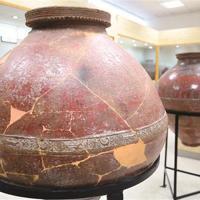Re: Armenian Art works
DR. JACK KEVORKIAN'S ART, BELONGINGS TO BE SOLD
CBS News
Sept 30 2011
(AP) DETROIT - Paintings, writings and the iconic blue sweater of
assisted suicide advocate Jack Kevorkian are going up for auction,
his attorney and close friend said Friday.
Lawyer Mayer Morganroth said the late pathologist's artwork and items
will be sold in late October at the New York Institute of Technology.
Scheduled for auction are more than 20 paintings, Kevorkian's art kit
and the sweaters he became known for donning during his high-profile
assistance in the suicides of dozens of people in the 1990s.
Many of the paintings depict death or dying, and are often intended to
provoke or disturb. One of those up for auction is entitled "Genocide,"
and features a bloody head being dangled by the hair and held by the
hands of two soldiers. One wears a German military uniform from World
War II and the other a Turkish uniform from World War I.
Morganroth said Kevorkian wanted to depict the mass killings of
Armenians and xxxs during World I and World War II, respectively. The
doctor was of Armenian descent.
"Just looking at it, you can say (it's) grotesque," Morganroth said.
"They were to make a point, like any art."
CBS Detroit first reported the auction plan.
Morganroth said he doesn't know the value of the collection but most
of the proceeds will go to Kevorkian's sole heir - a niece - and the
charity Kicking Cancer for Kids. Morganroth said the timing was right
to sell the items, since there was interest from several auction houses
and the broader art world, as well as a desire to settle the estate.
The Associated Press left a message seeking comment with the New York
Institute of Technology.
Kevorkian was convicted of second-degree murder in 1999, and was
released from prison in 2007. He died in June at the age of 83.
Suburban Detroit art gallery owner Anne Kuffler, who has twice
displayed Kevorkian's work and sells signed and numbered lithographs
of six of his works for $500 apiece, said she was offered $100,000
for one of his original paintings during the first exhibit of his
work in 1994. Kuffler, owner of the Ariana Gallery in Royal Oak,
suspects that the value has only increased since then.
"I had several orders for his prints this morning," she said.
Kuffler recalled an argument with Kevorkian, who painted the frame of
"Genocide" with his own blood and wanted to have a skeleton with an
IV flowing through it next to the painting.
"He said, 'I want to show how horrible it is, I want people to be
upset by it,'" Kuffler said. "I said, 'If you haven't portrayed it
in your painting, then you haven't succeeded.'"
Many of the paintings have been hanging at the Armenian Library and
Museum of America in Watertown, Mass., which also has a collection
of his compositions and writings. Kevorkian was also a keen musician
and composer.
"I think the legacy is showing the many facets of him and his
capabilities," Morganroth said. "He was a multi-talented man."
DR. JACK KEVORKIAN'S ART, BELONGINGS TO BE SOLD
CBS News
Sept 30 2011
(AP) DETROIT - Paintings, writings and the iconic blue sweater of
assisted suicide advocate Jack Kevorkian are going up for auction,
his attorney and close friend said Friday.
Lawyer Mayer Morganroth said the late pathologist's artwork and items
will be sold in late October at the New York Institute of Technology.
Scheduled for auction are more than 20 paintings, Kevorkian's art kit
and the sweaters he became known for donning during his high-profile
assistance in the suicides of dozens of people in the 1990s.
Many of the paintings depict death or dying, and are often intended to
provoke or disturb. One of those up for auction is entitled "Genocide,"
and features a bloody head being dangled by the hair and held by the
hands of two soldiers. One wears a German military uniform from World
War II and the other a Turkish uniform from World War I.
Morganroth said Kevorkian wanted to depict the mass killings of
Armenians and xxxs during World I and World War II, respectively. The
doctor was of Armenian descent.
"Just looking at it, you can say (it's) grotesque," Morganroth said.
"They were to make a point, like any art."
CBS Detroit first reported the auction plan.
Morganroth said he doesn't know the value of the collection but most
of the proceeds will go to Kevorkian's sole heir - a niece - and the
charity Kicking Cancer for Kids. Morganroth said the timing was right
to sell the items, since there was interest from several auction houses
and the broader art world, as well as a desire to settle the estate.
The Associated Press left a message seeking comment with the New York
Institute of Technology.
Kevorkian was convicted of second-degree murder in 1999, and was
released from prison in 2007. He died in June at the age of 83.
Suburban Detroit art gallery owner Anne Kuffler, who has twice
displayed Kevorkian's work and sells signed and numbered lithographs
of six of his works for $500 apiece, said she was offered $100,000
for one of his original paintings during the first exhibit of his
work in 1994. Kuffler, owner of the Ariana Gallery in Royal Oak,
suspects that the value has only increased since then.
"I had several orders for his prints this morning," she said.
Kuffler recalled an argument with Kevorkian, who painted the frame of
"Genocide" with his own blood and wanted to have a skeleton with an
IV flowing through it next to the painting.
"He said, 'I want to show how horrible it is, I want people to be
upset by it,'" Kuffler said. "I said, 'If you haven't portrayed it
in your painting, then you haven't succeeded.'"
Many of the paintings have been hanging at the Armenian Library and
Museum of America in Watertown, Mass., which also has a collection
of his compositions and writings. Kevorkian was also a keen musician
and composer.
"I think the legacy is showing the many facets of him and his
capabilities," Morganroth said. "He was a multi-talented man."








Comment